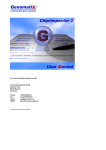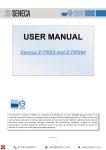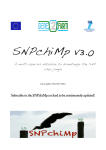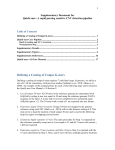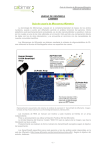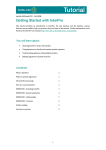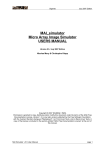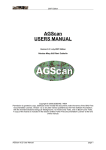Download The biomaRt user's guide
Transcript
The biomaRt user’s guide Steffen Durinck∗, Wolfgang Huber† September 15, 2015 Contents 1 Introduction 2 2 Selecting a BioMart database and dataset 3 3 How to build a biomaRt query 7 4 Examples of biomaRt queries 4.1 Task 1: Annotate a set of Affymetrix identifiers with HUGO symbol and chromosomal locations of corresponding genes . . 4.2 Task 2: Annotate a set of EntrezGene identifiers with GO annotation . . . . . . . . . . . . . . . . . . . . . . . . . . . . . 4.3 Task 3: Retrieve all HUGO gene symbols of genes that are located on chromosomes 17,20 or Y , and are associated with one the following GO terms: ”GO:0051330”,”GO:0000080”,”GO:0000114”,”GO:0000082” (here we’ll use more than one filter) . . . . . . . . . . . . . . 4.4 Task 4: Annotate set of idenfiers with INTERPRO protein domain identifiers . . . . . . . . . . . . . . . . . . . . . . . . . 4.5 Task 5: Select all Affymetrix identifiers on the hgu133plus2 chip and Ensembl gene identifiers for genes located on chromosome 16 between basepair 1100000 and 1250000. . . . . . . 4.6 Task 6: Retrieve all entrezgene identifiers and HUGO gene symbols of genes which have a ”MAP kinase activity” GO term associated with it. . . . . . . . . . . . . . . . . . . . . . 9 ∗ † [email protected] [email protected] 1 9 9 10 10 11 11 4.7 Task 7: Given a set of EntrezGene identifiers, retrieve 100bp upstream promoter sequences . . . . . . . . . . . . . . . . . . 4.8 Task 8: Retrieve all 5’ UTR sequences of all genes that are located on chromosome 3 between the positions 185514033 and 185535839 . . . . . . . . . . . . . . . . . . . . . . . . . . 4.9 Task 9: Retrieve protein sequences for a given list of EntrezGene identifiers . . . . . . . . . . . . . . . . . . . . . . . . . . 4.10 Task 10: Retrieve known SNPs located on the human chromosome 8 between positions 148350 and 148612 . . . . . . . . 4.11 Task 11: Given the human gene TP53, retrieve the human chromosomal location of this gene and also retrieve the chromosomal location and RefSeq id of it’s homolog in mouse. . . . . . . . . . . . . . . . . . . . . . . . . . . . . . . . . . . . 12 13 13 14 14 5 Using archived versions of Ensembl 15 5.1 Using the archive=TRUE . . . . . . . . . . . . . . . . . . . . 15 5.2 Accessing archives through specifying the archive host . . . . 16 6 Using a BioMart other than Ensembl 16 7 biomaRt helper functions 7.1 exportFASTA . . . . . . . . . 7.2 Finding out more information 7.2.1 filterType . . . . . . . 7.2.2 filterOptions . . . . . 7.3 Attribute Pages . . . . . . . . 17 17 17 17 17 18 . . . . . . on filters . . . . . . . . . . . . . . . . . . . . . . . . . . . . . . . . . . . . . . . . . . . . . . . . . . . . . . . . . . . . . . . . . . . . . . . . . . . . . . 8 Local BioMart databases 22 8.1 Minimum requirements for local database installation . . . . 23 9 Using select 23 10 Session Info 25 1 Introduction In recent years a wealth of biological data has become available in public data repositories. Easy access to these valuable data resources and firm integration with data analysis is needed for comprehensive bioinformatics data analysis. The biomaRt package, provides an interface to a growing 2 collection of databases implementing the BioMart software suite (http:// www.biomart.org). The package enables retrieval of large amounts of data in a uniform way without the need to know the underlying database schemas or write complex SQL queries. Examples of BioMart databases are Ensembl, Uniprot and HapMap. These major databases give biomaRt users direct access to a diverse set of data and enable a wide range of powerful online queries from R. 2 Selecting a BioMart database and dataset Every analysis with biomaRt starts with selecting a BioMart database to use. A first step is to check which BioMart web services are available. The function listMarts will display all available BioMart web services > library("biomaRt") > listMarts() biomart 1 ensembl 2 snp 3 regulation 4 vega 5 fungi_mart_28 6 fungi_variations_28 7 metazoa_mart_28 8 metazoa_variations_28 9 plants_mart_28 10 plants_variations_28 11 protists_mart_28 12 protists_variations_28 13 msd 14 cg_mart_02 15 WS220 16 parasite_mart 17 biomart 18 example 19 prod-intermart_1 20 unimart 21 biomartDB 22 biblioDB 23 Eurexpress Biomart 24 phytozome_mart 25 metazome_mart 26 HapMap_rel27 27 GermOnline 28 Sigenae_Oligo_Annotation_Ensembl_61 29 Sigenae Oligo Annotation (Ensembl 59) 30 Sigenae Oligo Annotation (Ensembl 56) 31 Breast_mart_69 32 K562_Gm12878 33 Hsmm_Hmec 3 34 35 36 37 38 39 40 41 42 43 44 45 46 47 48 49 50 51 52 allo2012 Pancreas63 Public_OBIOMARTPUB Public_VITIS Public_VITIS_12x Prod_WHEAT Public_TAIRV10 Public_MAIZE Prod_TOMATO Prod_POPLAR Prod_POPLAR_V2 Prod_BOTRYTISEDIT Prod_BOFUB Prod_LMACULANSEDIT vb_gene_mart_1506 vb_snp_mart_1506 expression ENSEMBL_MART_PLANT ENSEMBL_MART_PLANT_SNP 1 ENSEMBL GEN 2 ENSEMBL VARIATI 3 ENSEMBL REGULATI 4 VEG 5 ENSEMBL 6 ENSEMBL FUNGI VARI 7 ENSEMBL ME 8 ENSEMBL METAZOA VARI 9 ENSEMBL P 10 ENSEMBL PLANTS VARI 11 ENSEMBL PRO 12 ENSEMBL PROTISTS VARI 13 14 PROTEOMICS (UNIVERSITY O 15 WORMB 16 17 MGI (JACKS 18 FANTOM5 phase1.1 (R 19 20 21 PARAMECIUM GEN 22 PARAMECIUM BIBLIOGRA 23 EUREXPRESS ( 24 25 26 HA 27 28 SIGENAE OLIGO ANNOTA 29 SIGENAE OLIGO ANNOTA 30 SIGENAE OLIGO ANNOTA 31 BCCTB Bioinformatics Portal 32 Regulatory Genomics Group: Predictive models of gene regulation from processed high-throughput epigenomics data: 33 Regulatory Genomics Group: Predictive models of gene regulation from processed high-throughput epigenomics da 34 Regulatory Genomics Group: 35 PANCREATIC EXPRESSION DATABASE (BARTS CAN 36 Multi-species: marker, QTL, SNP, gene, germplasm, phenotype, association, with 4 37 38 39 40 41 42 43 44 45 46 47 48 49 50 51 52 Grapevine 8x, stuctural annotation with Genetic maps (g Grapevine 12x.0, stuctural and functional annotation with Genetic maps (g Wheat, stuctural annotation with Genetic maps (g Arabidopsis Thaliana TAIRV10, genes func Zea mays ZmB73, genes func Tomato, stuctural and func Populus trichocarpa, genes func Populus trichocarpa, genes functiona Botrytis cinerea T4, genes funct Botrytis cinerea B0510, genes funct Leptosphaeria maculans, genes func Vec Vect GRAMENE 40 ENSEMBL GENES GRAMENE 40 VARIATION Note: if the function useMart runs into proxy problems you should set your proxy first before calling any biomaRt functions. You can do this using the Sys.putenv command: Sys.putenv("http\_proxy" = "http://my.proxy.org:9999") Some users have reported that the workaround above does not work, in this case an alternative proxy solution below can be tried: options(RCurlOptions = list(proxy="uscache.kcc.com:80",proxyuserpwd="------:-------")) The useMart function can now be used to connect to a specified BioMart database, this must be a valid name given by listMarts. In the next example we choose to query the Ensembl BioMart database. > ensembl=useMart("ensembl") BioMart databases can contain several datasets, for Ensembl every species is a different dataset. In a next step we look at which datasets are available in the selected BioMart by using the function listDatasets. > listDatasets(ensembl) 1 2 3 4 5 6 7 8 dataset oanatinus_gene_ensembl cporcellus_gene_ensembl gaculeatus_gene_ensembl lafricana_gene_ensembl itridecemlineatus_gene_ensembl choffmanni_gene_ensembl csavignyi_gene_ensembl fcatus_gene_ensembl description version Ornithorhynchus anatinus genes (OANA5) OANA5 Cavia porcellus genes (cavPor3) cavPor3 Gasterosteus aculeatus genes (BROADS1) BROADS1 Loxodonta africana genes (loxAfr3) loxAfr3 Ictidomys tridecemlineatus genes (spetri2) spetri2 Choloepus hoffmanni genes (choHof1) choHof1 Ciona savignyi genes (CSAV2.0) CSAV2.0 Felis catus genes (Felis_catus_6.2) Felis_catus_6.2 5 9 10 11 12 13 14 15 16 17 18 19 20 21 22 23 24 25 26 27 28 29 30 31 32 33 34 35 36 37 38 39 40 41 42 43 44 45 46 47 48 49 50 51 52 53 54 55 56 57 58 59 60 61 62 63 64 rnorvegicus_gene_ensembl Rattus norvegicus genes (Rnor_6.0) psinensis_gene_ensembl Pelodiscus sinensis genes (PelSin_1.0) cjacchus_gene_ensembl Callithrix jacchus genes (C_jacchus3.2.1) ttruncatus_gene_ensembl Tursiops truncatus genes (turTru1) scerevisiae_gene_ensembl Saccharomyces cerevisiae genes (R64-1-1) celegans_gene_ensembl Caenorhabditis elegans genes (WBcel235) csabaeus_gene_ensembl Chlorocebus sabaeus genes (ChlSab1.1) oniloticus_gene_ensembl Oreochromis niloticus genes (Orenil1.0) trubripes_gene_ensembl Takifugu rubripes genes (FUGU4.0) amexicanus_gene_ensembl Astyanax mexicanus genes (AstMex102) pmarinus_gene_ensembl Petromyzon marinus genes (Pmarinus_7.0) eeuropaeus_gene_ensembl Erinaceus europaeus genes (eriEur1) falbicollis_gene_ensembl Ficedula albicollis genes (FicAlb_1.4) ptroglodytes_gene_ensembl Pan troglodytes genes (CHIMP2.1.4) etelfairi_gene_ensembl Echinops telfairi genes (TENREC) cintestinalis_gene_ensembl Ciona intestinalis genes (KH) nleucogenys_gene_ensembl Nomascus leucogenys genes (Nleu1.0) sscrofa_gene_ensembl Sus scrofa genes (Sscrofa10.2) ocuniculus_gene_ensembl Oryctolagus cuniculus genes (OryCun2.0) dnovemcinctus_gene_ensembl Dasypus novemcinctus genes (Dasnov3.0) pcapensis_gene_ensembl Procavia capensis genes (proCap1) tguttata_gene_ensembl Taeniopygia guttata genes (taeGut3.2.4) mlucifugus_gene_ensembl Myotis lucifugus genes (myoLuc2) hsapiens_gene_ensembl Homo sapiens genes (GRCh38.p3) pformosa_gene_ensembl Poecilia formosa genes (PoeFor_5.1.2) mfuro_gene_ensembl Mustela putorius furo genes (MusPutFur1.0) tbelangeri_gene_ensembl Tupaia belangeri genes (tupBel1) ggallus_gene_ensembl Gallus gallus genes (Galgal4) xtropicalis_gene_ensembl Xenopus tropicalis genes (JGI4.2) ecaballus_gene_ensembl Equus caballus genes (EquCab2) pabelii_gene_ensembl Pongo abelii genes (PPYG2) xmaculatus_gene_ensembl Xiphophorus maculatus genes (Xipmac4.4.2) drerio_gene_ensembl Danio rerio genes (GRCz10) lchalumnae_gene_ensembl Latimeria chalumnae genes (LatCha1) tnigroviridis_gene_ensembl Tetraodon nigroviridis genes (TETRAODON8.0) amelanoleuca_gene_ensembl Ailuropoda melanoleuca genes (ailMel1) mmulatta_gene_ensembl Macaca mulatta genes (MMUL_1) pvampyrus_gene_ensembl Pteropus vampyrus genes (pteVam1) panubis_gene_ensembl Papio anubis genes (PapAnu2.0) mdomestica_gene_ensembl Monodelphis domestica genes (monDom5) acarolinensis_gene_ensembl Anolis carolinensis genes (AnoCar2.0) vpacos_gene_ensembl Vicugna pacos genes (vicPac1) tsyrichta_gene_ensembl Tarsius syrichta genes (tarSyr1) ogarnettii_gene_ensembl Otolemur garnettii genes (OtoGar3) dmelanogaster_gene_ensembl Drosophila melanogaster genes (BDGP6) mmurinus_gene_ensembl Microcebus murinus genes (micMur1) loculatus_gene_ensembl Lepisosteus oculatus genes (LepOcu1) olatipes_gene_ensembl Oryzias latipes genes (HdrR) ggorilla_gene_ensembl Gorilla gorilla genes (gorGor3.1) oprinceps_gene_ensembl Ochotona princeps genes (OchPri2.0) dordii_gene_ensembl Dipodomys ordii genes (dipOrd1) oaries_gene_ensembl Ovis aries genes (Oar_v3.1) mmusculus_gene_ensembl Mus musculus genes (GRCm38.p4) mgallopavo_gene_ensembl Meleagris gallopavo genes (UMD2) gmorhua_gene_ensembl Gadus morhua genes (gadMor1) aplatyrhynchos_gene_ensembl Anas platyrhynchos genes (BGI_duck_1.0) 6 Rnor_6.0 PelSin_1.0 C_jacchus3.2.1 turTru1 R64-1-1 WBcel235 ChlSab1.1 Orenil1.0 FUGU4.0 AstMex102 Pmarinus_7.0 eriEur1 FicAlb_1.4 CHIMP2.1.4 TENREC KH Nleu1.0 Sscrofa10.2 OryCun2.0 Dasnov3.0 proCap1 taeGut3.2.4 myoLuc2 GRCh38.p3 PoeFor_5.1.2 MusPutFur1.0 tupBel1 Galgal4 JGI4.2 EquCab2 PPYG2 Xipmac4.4.2 GRCz10 LatCha1 TETRAODON8.0 ailMel1 MMUL_1 pteVam1 PapAnu2.0 monDom5 AnoCar2.0 vicPac1 tarSyr1 OtoGar3 BDGP6 micMur1 LepOcu1 HdrR gorGor3.1 OchPri2.0 dipOrd1 Oar_v3.1 GRCm38.p4 UMD2 gadMor1 BGI_duck_1.0 65 66 67 68 69 saraneus_gene_ensembl sharrisii_gene_ensembl meugenii_gene_ensembl btaurus_gene_ensembl cfamiliaris_gene_ensembl Sorex araneus genes (sorAra1) Sarcophilus harrisii genes (DEVIL7.0) Macropus eugenii genes (Meug_1.0) Bos taurus genes (UMD3.1) Canis familiaris genes (CanFam3.1) sorAra1 DEVIL7.0 Meug_1.0 UMD3.1 CanFam3.1 To select a dataset we can update the Mart object using the function useDataset. In the example below we choose to use the hsapiens dataset. ensembl = useDataset("hsapiens_gene_ensembl",mart=ensembl) Or alternatively if the dataset one wants to use is known in advance, we can select a BioMart database and dataset in one step by: > ensembl = useMart("ensembl",dataset="hsapiens_gene_ensembl") 3 How to build a biomaRt query The getBM function has three arguments that need to be introduced: filters, attributes and values. Filters define a restriction on the query. For example you want to restrict the output to all genes located on the human X chromosome then the filter chromosome name can be used with value ’X’. The listFilters function shows you all available filters in the selected dataset. > filters = listFilters(ensembl) > filters[1:5,] 1 2 3 4 5 name description chromosome_name Chromosome name start Gene Start (bp) end Gene End (bp) band_start Band Start band_end Band End Attributes define the values we are interested in to retrieve. For example we want to retrieve the gene symbols or chromosomal coordinates. The listAttributes function displays all available attributes in the selected dataset. > attributes = listAttributes(ensembl) > attributes[1:5,] 7 name description 1 ensembl_gene_id Ensembl Gene ID 2 ensembl_transcript_id Ensembl Transcript ID 3 ensembl_peptide_id Ensembl Protein ID 4 ensembl_exon_id Ensembl Exon ID 5 description Description The getBM function is the main query function in biomaRt. It has four main arguments: attributes: is a vector of attributes that one wants to retrieve (= the output of the query). filters: is a vector of filters that one wil use as input to the query. values: a vector of values for the filters. In case multple filters are in use, the values argument requires a list of values where each position in the list corresponds to the position of the filters in the filters argument (see examples below). mart: is and object of class Mart, which is created by the useMart function. Note: for some frequently used queries to Ensembl, wrapper functions are available: getGene and getSequence. These functions call the getBM function with hard coded filter and attribute names. Now that we selected a BioMart database and dataset, and know about attributes, filters, and the values for filters; we can build a biomaRt query. Let’s make an easy query for the following problem: We have a list of Affymetrix identifiers from the u133plus2 platform and we want to retrieve the corresponding EntrezGene identifiers using the Ensembl mappings. The u133plus2 platform will be the filter for this query and as values for this filter we use our list of Affymetrix identifiers. As output (attributes) for the query we want to retrieve the EntrezGene and u133plus2 identifiers so we get a mapping of these two identifiers as a result. The exact names that we will have to use to specify the attributes and filters can be retrieved with the listAttributes and listFilters function respectively. Let’s now run the query: > affyids=c("202763_at","209310_s_at","207500_at") > getBM(attributes=c('affy_hg_u133_plus_2', 'entrezgene'), filters = 'affy_hg_u133_plus_2', values = affyids, mart = 8 1 2 3 affy_hg_u133_plus_2 entrezgene 209310_s_at 837 207500_at 838 202763_at 836 4 Examples of biomaRt queries In the sections below a variety of example queries are described. Every example is written as a task, and we have to come up with a biomaRt solution to the problem. 4.1 Task 1: Annotate a set of Affymetrix identifiers with HUGO symbol and chromosomal locations of corresponding genes We have a list of Affymetrix hgu133plus2 identifiers and we would like to retrieve the HUGO gene symbols, chromosome names, start and end positions and the bands of the corresponding genes. The listAttributes and the listFilters functions give us an overview of the available attributes and filters and we look in those lists to find the corresponding attribute and filter names we need. For this query we’ll need the following attributes: hgnc symbol, chromsome name, start position, end position, band and affy hg u133 plus 2 (as we want these in the output to provide a mapping with our original Affymetrix input identifiers. There is one filter in this query which is the affy hg u133 plus 2 filter as we use a list of Affymetrix identifiers as input. Putting this all together in the getBM and performing the query gives: > affyids=c("202763_at","209310_s_at","207500_at") > getBM(attributes=c('affy_hg_u133_plus_2', 'hgnc_symbol', 'chromosome_name','start_position','end_position', 'band') + filters = 'affy_hg_u133_plus_2', values = affyids, mart = ensembl) 1 2 3 affy_hg_u133_plus_2 hgnc_symbol chromosome_name start_position end_position band 209310_s_at CASP4 11 104813593 104840163 q22.3 207500_at CASP5 11 104864962 104893895 q22.3 202763_at CASP3 4 185548850 185570663 q35.1 4.2 Task 2: Annotate a set of EntrezGene identifiers with GO annotation In this task we start out with a list of EntrezGene identiers and we want to retrieve GO identifiers related to biological processes that are associated with these entrezgene identifiers. Again we look at the output of listAttributes and listFilters to find the filter and attributes we need. Then we construct the following query: 9 > entrez=c("673","837") > goids = getBM(attributes=c('entrezgene','go_id'), filters='entrezgene', values=entrez, mart=ensembl) > head(goids) 1 2 3 4 5 entrezgene 673 673 673 673 673 4.3 go_id GO:0000186 GO:0006468 GO:0006916 GO:0007264 GO:0007268 Task 3: Retrieve all HUGO gene symbols of genes that are located on chromosomes 17,20 or Y , and are associated with one the following GO terms: ”GO:0051330”,”GO:0000080”,”GO:0000114”,”GO:0000082” (here we’ll use more than one filter) The getBM function enables you to use more than one filter. In this case the filter argument should be a vector with the filter names. The values should be a list, where the first element of the list corresponds to the first filter and the second list element to the second filter and so on. The elements of this list are vectors containing the possible values for the corresponding filters. go=c("GO:0051330","GO:0000080","GO:0000114") chrom=c(17,20,"Y") getBM(attributes= "hgnc_symbol", filters=c("go_id","chromosome_name"), values=list(go,chrom), mart=ensembl) 1 hgnc_symbol E2F1 4.4 Task 4: Annotate set of idenfiers with INTERPRO protein domain identifiers In this example we want to annotate the following two RefSeq identifiers: NM 005359 and NM 000546 with INTERPRO protein domain identifiers and a description of the protein domains. > refseqids = c("NM_005359","NM_000546") > ipro = getBM(attributes=c("refseq_dna","interpro","interpro_description"), filters=" ipro refseq_dna interpro 1 NM_000546 IPR002117 2 NM_000546 IPR010991 interpro_description p53 tumor antigen p53, tetramerisation 10 3 4 5 6 7 8 NM_000546 NM_000546 NM_000546 NM_005359 NM_005359 NM_005359 4.5 IPR011615 p53, DNA-binding IPR013872 p53 transactivation domain (TAD) IPR000694 Proline-rich region IPR001132 MAD homology 2, Dwarfin-type IPR003619 MAD homology 1, Dwarfin-type IPR013019 MAD homology, MH1 Task 5: Select all Affymetrix identifiers on the hgu133plus2 chip and Ensembl gene identifiers for genes located on chromosome 16 between basepair 1100000 and 1250000. In this example we will again use multiple filters: chromosome name, start, and end as we filter on these three conditions. Note that when a chromosome name, a start position and an end position are jointly used as filters, the BioMart webservice interprets this as return everything from the given chromosome between the given start and end positions. > getBM(c('affy_hg_u133_plus_2','ensembl_gene_id'), filters = c('chromosome_name','start','end'), + values=list(16,1100000,1250000), mart=ensembl) 1 2 3 4 5 6 7 8 9 10 11 12 13 14 15 16 17 18 19 20 21 22 23 affy_hg_u133_plus_2 ensembl_gene_id ENSG00000260702 215502_at ENSG00000260532 ENSG00000273551 205845_at ENSG00000196557 ENSG00000196557 ENSG00000260403 ENSG00000259910 ENSG00000261294 220339_s_at ENSG00000116176 ENSG00000277010 217023_x_at ENSG00000197253 210084_x_at ENSG00000197253 215382_x_at ENSG00000197253 216474_x_at ENSG00000197253 207134_x_at ENSG00000197253 205683_x_at ENSG00000197253 217023_x_at ENSG00000172236 210084_x_at ENSG00000172236 215382_x_at ENSG00000172236 207741_x_at ENSG00000172236 216474_x_at ENSG00000172236 207134_x_at ENSG00000172236 205683_x_at ENSG00000172236 4.6 Task 6: Retrieve all entrezgene identifiers and HUGO gene symbols of genes which have a ”MAP kinase activity” GO term associated with it. The GO identifier for MAP kinase activity is GO:0004707. In our query we will use go as filter and entrezgene and hgnc symbol as attributes. Here’s the query: 11 > getBM(c('entrezgene','hgnc_symbol'), filters='go', values='GO:0004707', mart=ensembl) 1 2 3 4 5 entrezgene hgnc_symbol 5601 MAPK9 225689 MAPK15 5599 MAPK8 5594 MAPK1 6300 MAPK12 4.7 Task 7: Given a set of EntrezGene identifiers, retrieve 100bp upstream promoter sequences All sequence related queries to Ensembl are available through the getSequence wrapper function. getBM can also be used directly to retrieve sequences but this can get complicated so using getSequence is recommended. Sequences can be retrieved using the getSequence function either starting from chromosomal coordinates or identifiers. The chromosome name can be specified using the chromosome argument. The start and end arguments are used to specify start and end positions on the chromosome. The type of sequence returned can be specified by the seqType argument which takes the following values: ’cdna’;’peptide’ for protein sequences;’3utr’ for 3’ UTR sequences,’5utr’ for 5’ UTR sequences; ’gene exon’ for exon sequences only; ’transcript exon’ for transcript specific exonic sequences only;’transcript exon intron’ gives the full unspliced transcript, that is exons + introns;’gene exon intron’ gives the exons + introns of a gene;’coding’ gives the coding sequence only;’coding transcript flank’ gives the flanking region of the transcript including the UTRs, this must be accompanied with a given value for the upstream or downstream attribute;’coding gene flank’ gives the flanking region of the gene including the UTRs, this must be accompanied with a given value for the upstream or downstream attribute; ’transcript flank’ gives the flanking region of the transcript exculding the UTRs, this must be accompanied with a given value for the upstream or downstream attribute; ’gene flank’ gives the flanking region of the gene excluding the UTRs, this must be accompanied with a given value for the upstream or downstream attribute. In MySQL mode the getSequence function is more limited and the sequence that is returned is the 5’ to 3’+ strand of the genomic sequence, given a chromosome, as start and an end position. Task 4 requires us to retrieve 100bp upstream promoter sequences from a set of EntrzGene identifiers. The type argument in getSequence can be thought of as the filter in this query and uses the same input names given by 12 listFilters. in our query we use entrezgene for the type argument. Next we have to specify which type of sequences we want to retrieve, here we are interested in the sequences of the promoter region, starting right next to the coding start of the gene. Setting the seqType to coding gene flank will give us what we need. The upstream argument is used to specify how many bp of upstream sequence we want to retrieve, here we’ll retrieve a rather short sequence of 100bp. Putting this all together in getSequence gives: > entrez=c("673","7157","837") > getSequence(id = entrez, type="entrezgene",seqType="coding_gene_flank",upstream=100, mart=ensembl) 4.8 Task 8: Retrieve all 5’ UTR sequences of all genes that are located on chromosome 3 between the positions 185514033 and 185535839 As described in the provious task getSequence can also use chromosomal coordinates to retrieve sequences of all genes that lie in the given region. We also have to specify which type of identifier we want to retrieve together with the sequences, here we choose for entrezgene identifiers. > utr5 = getSequence(chromosome=3, start=185514033, end=185535839, + type="entrezgene",seqType="5utr", mart=ensembl) > utr5 V1 .....GAAGCGGTGGC .... 4.9 V2 1981 Task 9: Retrieve protein sequences for a given list of EntrezGene identifiers In this task the type argument specifies which type of identifiers we are using. To get an overview of other valid identifier types we refer to the listFilters function. > protein = getSequence(id=c(100, 5728),type="entrezgene", + seqType="peptide", mart=ensembl) > protein peptide MAQTPAFDKPKVEL ... MTAIIKEIVSRNKRR ... entrezgene 100 5728 13 4.10 Task 10: Retrieve known SNPs located on the human chromosome 8 between positions 148350 and 148612 For this example we’ll first have to connect to a different BioMart database, namely snp. > snpmart = useMart("snp", dataset="hsapiens_snp") The listAttributes and listFilters functions give us an overview of the available attributes and filters. From these we need: refsnp id, allele, chrom start and chrom strand as attributes; and as filters we’ll use: chrom start, chrom end and chr name. Note that when a chromosome name, a start position and an end position are jointly used as filters, the BioMart webservice interprets this as return everything from the given chromosome between the given start and end positions. Putting our selected attributes and filters into getBM gives: > getBM(c('refsnp_id','allele','chrom_start','chrom_strand'), filters = c('chr_name','chrom_start','chrom_end'), valu refsnp_id allele chrom_start chrom_strand 1 rs1134195 G/T 148394 -1 2 rs4046274 C/A 148394 1 3 rs4046275 A/G 148411 1 4 rs13291 C/T 148462 1 5 rs1134192 G/A 148462 -1 6 rs4046276 C/T 148462 1 7 rs12019378 T/G 148471 1 8 rs1134191 C/T 148499 -1 9 rs4046277 G/A 148499 1 10 rs11136408 G/A 148525 1 11 rs1134190 C/T 148533 -1 12 rs4046278 G/A 148533 1 13 rs1134189 G/A 148535 -1 14 rs3965587 C/T 148535 1 15 rs1134187 G/A 148539 -1 16 rs1134186 T/C 148569 1 17 rs4378731 G/A 148601 1 4.11 Task 11: Given the human gene TP53, retrieve the human chromosomal location of this gene and also retrieve the chromosomal location and RefSeq id of it’s homolog in mouse. The getLDS (Get Linked Dataset) function provides functionality to link 2 BioMart datasets which each other and construct a query over the two datasets. In Ensembl, linking two datasets translates to retrieving homology data across species. The usage of getLDS is very similar to getBM. The linked dataset is provided by a separate Mart object and one has to specify filters and attributes for the linked dataset. Filters can either be applied to both 14 datasets or to one of the datasets. Use the listFilters and listAttributes functions on both Mart objects to find the filters and attributes for each dataset (species in Ensembl). The attributes and filters of the linked dataset can be specified with the attributesL and filtersL arguments. Entering all this information into getLDS gives: human = useMart("ensembl", dataset = "hsapiens_gene_ensembl") mouse = useMart("ensembl", dataset = "mmusculus_gene_ensembl") getLDS(attributes = c("hgnc_symbol","chromosome_name", "start_position"), filters = "hgnc_symbol", values = "TP53",mart = human, attributesL = c("refseq_dna","chromosome_name","start_position"), martL = mouse) V1 V2 V3 V4 V5 V6 1 TP53 17 7512464 NM_011640 11 69396600 5 Using archived versions of Ensembl It is possible to query archived versions of Ensembl through biomaRt. There are currently two ways to access archived versions. 5.1 Using the archive=TRUE First we list the available Ensembl archives by using the listMarts function and setting the archive attribute to TRUE. Note that not all archives are available this way and it seems that recently this only gives access to few archives if you don’t see the version of the archive you need please look at the 2nd way to access archives. > listMarts(archive=TRUE) 1 2 3 4 5 6 7 8 9 10 11 12 13 14 15 16 17 18 19 20 21 biomart ensembl_mart_47 genomic_features_mart_47 snp_mart_47 vega_mart_47 compara_mart_homology_47 compara_mart_multiple_ga_47 compara_mart_pairwise_ga_47 ensembl_mart_46 genomic_features_mart_46 snp_mart_46 vega_mart_46 compara_mart_homology_46 compara_mart_multiple_ga_46 compara_mart_pairwise_ga_46 ensembl_mart_45 snp_mart_45 vega_mart_45 compara_mart_homology_45 compara_mart_multiple_ga_45 compara_mart_pairwise_ga_45 ensembl_mart_44 version ENSEMBL GENES 47 (SANGER) Genomic Features SNP Vega Compara homology Compara multiple alignments Compara pairwise alignments ENSEMBL GENES 46 (SANGER) Genomic Features SNP Vega Compara homology Compara multiple alignments Compara pairwise alignments ENSEMBL GENES 45 (SANGER) SNP Vega Compara homology Compara multiple alignments Compara pairwise alignments ENSEMBL GENES 44 (SANGER) 15 22 snp_mart_44 SNP 23 vega_mart_44 Vega 24 compara_mart_homology_44 Compara homology 25 compara_mart_pairwise_ga_44 Compara pairwise alignments 26 ensembl_mart_43 ENSEMBL GENES 43 (SANGER) 27 snp_mart_43 SNP 28 vega_mart_43 Vega 29 compara_mart_homology_43 Compara homology 30 compara_mart_pairwise_ga_43 Compara pairwise alignments Next we select the archive we want to use using the useMart function, again setting the archive attribute to TRUE and giving the full name of the BioMart e.g. ensembl mart 46. > ensembl = useMart("ensembl_mart_46", dataset="hsapiens_gene_ensembl", archive = TRUE If you don’t know the dataset you want to use could first connect to the BioMart using useMart and then use the listDatasets function on this object. After you selected the BioMart database and dataset, queries can be performed in the same way as when using the current BioMart versions. 5.2 Accessing archives through specifying the archive host Use the http://www.ensembl.org website and go down the bottom of the page. Click on ’view in Archive’ and select the archive you need. Copy the url and use that url as shown below to connect to the specified BioMart database. The example below shows how to query Ensembl 54. > listMarts(host='may2009.archive.ensembl.org') > ensembl54=useMart(host='may2009.archive.ensembl.org', biomart='ENSEMBL_MART_ENSEMBL') > ensembl54=useMart(host='may2009.archive.ensembl.org', biomart='ENSEMBL_MART_ENSEMBL', dataset='hsapiens_gene_ensemb 6 Using a BioMart other than Ensembl To demonstrate the use of the biomaRt package with non-Ensembl databases the next query is performed using the Wormbase BioMart (WormMart). We connect to Wormbase, select the gene dataset to use and have a look at the available attributes and filters. Then we use a list of gene names as filter and retrieve associated RNAi identifiers together with a description of the RNAi phenotype. > > > > + + > wormbase=useMart("WS220",dataset="wormbase_gene") listFilters(wormbase) listAttributes(wormbase) getBM(attributes = c("public_name","rnai","rnai_phenotype_phenotype_label"), filters="gene_name", values=c("unc-26","his-33"), mart=wormbase) 16 1 2 3 4 5 6 public_name his-33 his-33 his-33 his-33 his-33 his-33 7 rnai rnai_phenotype_phenotype_label WBRNAi00082060 GRO slow growth WBRNAi00082060 postembryonic development variant WBRNAi00082060 EMB embryonic lethal WBRNAi00082060 LVL larval lethal WBRNAi00082060 LVA larval arrest WBRNAi00082060 accumulated cell corpses biomaRt helper functions This section describes a set of biomaRt helper functions that can be used to export FASTA format sequences, retrieve values for certain filters and exploring the available filters and attributes in a more systematic manner. 7.1 exportFASTA The data.frames obtained by the getSequence function can be exported to FASTA files using the exportFASTA function. One has to specify the data.frame to export and the filename using the file argument. 7.2 7.2.1 Finding out more information on filters filterType Boolean filters need a value TRUE or FALSE in biomaRt. Setting the value TRUE will include all information that fulfill the filter requirement. Setting FALSE will exclude the information that fulfills the filter requirement and will return all values that don’t fulfill the filter. For most of the filters, their name indicates if the type is a boolean or not and they will usually start with ”with”. However this is not a rule and to make sure you got the type right you can use the function filterType to investigate the type of the filter you want to use. > filterType("with_affy_hg_u133_plus_2",ensembl) [1] "boolean_list" 7.2.2 filterOptions Some filters have a limited set of values that can be given to them. To know which values these are one can use the filterOptions function to retrieve the predetermed values of the respective filter. 17 > filterOptions("biotype",ensembl) [1] "[3prime_overlapping_ncrna,antisense,IG_C_gene,IG_C_pseudogene,IG_D_gene,IG_J_gene,IG_J_ps If there are no predetermed values e.g. for the entrezgene filter, then filterOptions will return the type of filter it is. And most of the times the filter name or it’s description will suggest what values one case use for the respective filter (e.g. entrezgene filter will work with enterzgene identifiers as values) 7.3 Attribute Pages For large BioMart databases such as Ensembl, the number of attributes displayed by the listAttributes function can be very large. In BioMart databases, attributes are put together in pages, such as sequences, features, homologs for Ensembl. An overview of the attributes pages present in the respective BioMart dataset can be obtained with the attributePages function. > pages = attributePages(ensembl) > pages [1] "feature_page" "structure" "homologs" "snp" "snp_somatic" "sequences" To show us a smaller list of attributes which belog to a specific page, we can now specify this in the listAttributes function as follows: > listAttributes(ensembl, page="feature_page") 1 2 3 4 5 6 7 8 9 10 11 12 13 14 15 name ensembl_gene_id ensembl_transcript_id ensembl_peptide_id ensembl_exon_id description chromosome_name start_position end_position strand band transcript_start transcript_end transcription_start_site transcript_length transcript_tsl 18 description Ensembl Gene ID Ensembl Transcript ID Ensembl Protein ID Ensembl Exon ID Description Chromosome Name Gene Start (bp) Gene End (bp) Strand Band Transcript Start (bp) Transcript End (bp) Transcription Start Site (TSS) Transcript length Transcript Support Level (TSL) 16 17 18 19 20 21 22 23 24 25 26 27 28 29 30 31 32 33 34 35 36 37 38 39 40 41 42 43 44 45 46 47 48 49 50 51 52 53 54 55 56 57 58 59 60 transcript_gencode_basic GENCODE basic annotation transcript_appris APPRIS annotation external_gene_name Associated Gene Name external_gene_source Associated Gene Source external_transcript_name Associated Transcript Name external_transcript_source_name Associated Transcript Source transcript_count Transcript count percentage_gc_content % GC content gene_biotype Gene type transcript_biotype Transcript type source Source (gene) transcript_source Source (transcript) status Status (gene) transcript_status Status (transcript) version Version (gene) transcript_version Version (transcript) phenotype_description Phenotype description source_name Source name study_external_id Study External Reference go_id GO Term Accession name_1006 GO Term Name definition_1006 GO Term Definition go_linkage_type GO Term Evidence Code namespace_1003 GO domain goslim_goa_accession GOSlim GOA Accession(s) goslim_goa_description GOSlim GOA Description arrayexpress ArrayExpress chembl ChEMBL ID(s) clone_based_ensembl_gene_name Clone based Ensembl gene name clone_based_ensembl_transcript_name Clone based Ensembl transcript name clone_based_vega_gene_name Clone based VEGA gene name clone_based_vega_transcript_name Clone based VEGA transcript name ccds CCDS ID dbass3_id Database of Aberrant 3' Splice Sites (DBASS3) IDs dbass3_name DBASS3 Gene Name dbass5_id Database of Aberrant 5' Splice Sites (DBASS5) IDs dbass5_name DBASS5 Gene Name embl EMBL (Genbank) ID ens_hs_gene Ensembl Human Gene IDs ens_hs_transcript Ensembl Human Transcript IDs ens_hs_translation Ensembl Human Translation IDs ens_lrg_gene LRG to Ensembl link gene ens_lrg_transcript LRG to Ensembl link transcript entrezgene EntrezGene ID entrezgene_transcript_name EntrezGene transcript name ID 19 61 hpa 62 ottg 63 ottt 64 ottp 65 hgnc_id 66 hgnc_symbol 67 hgnc_transcript_name 68 merops 69 mim_morbid_accession 70 mim_morbid_description 71 mim_gene_accession 72 mim_gene_description 73 mirbase_accession 74 mirbase_id 75 mirbase_transcript_name 76 pdb 77 protein_id 78 pubmed 79 reactome 80 reactome_gene 81 reactome_transcript 82 refseq_mrna 83 refseq_mrna_predicted 84 refseq_ncrna 85 refseq_ncrna_predicted 86 refseq_peptide 87 refseq_peptide_predicted 88 rfam 89 rfam_transcript_name 90 rnacentral 91 ucsc 92 unigene 93 uniparc 94 uniprot_sptrembl 95 uniprot_swissprot 96 uniprot_genename 97 uniprot_genename_transcript_name 98 wikigene_name 99 wikigene_id 100 wikigene_description 101 efg_agilent_sureprint_g3_ge_8x60k 102 efg_agilent_sureprint_g3_ge_8x60k_v2 103 efg_agilent_wholegenome_4x44k_v1 104 efg_agilent_wholegenome_4x44k_v2 105 affy_hc_g110 20 Human Protein Atlas Antibody ID VEGA gene ID(s) (OTTG) VEGA transcript ID(s) (OTTT) VEGA protein ID(s) (OTTP) HGNC ID(s) HGNC symbol HGNC transcript name MEROPS ID MIM Morbid Accession MIM Morbid Description MIM Gene Accession MIM Gene Description miRBase Accession(s) miRBase ID(s) miRBase transcript name PDB ID Protein (Genbank) ID [e.g. AAA02487] PubMed ID [e.g. 7716543] Reactome ID Reactome gene ID [e.g. REACT_1006] Reactome transcript ID [e.g. REACT_11045] RefSeq mRNA [e.g. NM_001195597] RefSeq mRNA predicted [e.g. XM_001125684] RefSeq ncRNA [e.g. NR_002834] RefSeq ncRNA predicted [e.g. XR_108264] RefSeq Protein ID [e.g. NP_001005353] RefSeq Predicted Protein ID [e.g. XP_001720922] Rfam ID Rfam transcript name RNACentral ID UCSC ID Unigene ID UniParc UniProt/TrEMBL Accession UniProt/SwissProt Accession UniProt Gene Name Uniprot Transcript Name WikiGene Name WikiGene ID WikiGene Description Agilent SurePrint G3 GE 8x60k probe Agilent SurePrint G3 GE 8x60k v2 probe Agilent WholeGenome 4x44k v1 probe Agilent WholeGenome 4x44k v2 probe Affy HC G110 probeset 106 107 108 109 110 111 112 113 114 115 116 117 118 119 120 121 122 123 124 125 126 127 128 129 130 131 132 133 134 135 136 137 138 139 140 141 142 143 144 145 146 147 148 149 150 affy_hg_focus affy_hg_u133_plus_2 affy_hg_u133a_2 affy_hg_u133a affy_hg_u133b affy_hg_u95av2 affy_hg_u95b affy_hg_u95c affy_hg_u95d affy_hg_u95e affy_hg_u95a affy_hugenefl affy_hta_2_0 affy_huex_1_0_st_v2 affy_hugene_1_0_st_v1 affy_hugene_2_0_st_v1 affy_primeview affy_u133_x3p agilent_cgh_44b codelink illumina_humanwg_6_v1 illumina_humanwg_6_v2 illumina_humanwg_6_v3 illumina_humanht_12_v3 illumina_humanht_12_v4 illumina_humanref_8_v3 phalanx_onearray family family_description pirsf pirsf_start pirsf_end superfamily superfamily_start superfamily_end smart smart_start smart_end hamap hamap_start hamap_end profile profile_start profile_end prosite 21 Affy HG FOCUS probeset Affy HG U133-PLUS-2 probeset Affy HG U133A_2 probeset Affy HG U133A probeset Affy HG U133B probeset Affy HG U95AV2 probeset Affy HG U95B probeset Affy HG U95C probeset Affy HG U95D probeset Affy HG U95E probeset Affy HG U95A probeset Affy HuGene FL probeset Affy HTA-2_0 probeset Affy HuEx 1_0 st v2 probeset Affy HuGene 1_0 st v1 probeset Affy HuGene 2_0 st v1 probeset Affy primeview Affy U133 X3P probeset Agilent CGH 44b probe Codelink probe Illumina HumanWG 6 v1 probe Illumina HumanWG 6 v2 probe Illumina HumanWG 6 v3 probe Illumina Human HT 12 V3 probe Illumina Human HT 12 V4 probe Illumina Human Ref 8 V3 probe Phalanx OneArray probe Ensembl Protein Family ID(s) Ensembl Family Description PIRSF ID PIRSF start PIRSF end SUPERFAMILY ID SUPERFAMILY start SUPERFAMILY end SMART ID SMART start SMART end HAMAP Accession ID HAMAP start HAMAP end Pfscan ID Pfscan start Pfscan end ScanProsite ID 151 152 153 154 155 156 157 158 159 160 161 162 163 164 165 166 167 168 169 170 171 172 173 174 175 176 177 178 179 180 181 182 183 184 prosite_start prosite_end prints prints_start prints_end pfam pfam_start pfam_end tigrfam tigrfam_start tigrfam_end gene3d gene3d_start gene3d_end hmmpanther hmmpanther_start hmmpanther_end interpro interpro_short_description interpro_description interpro_start interpro_end low_complexity low_complexity_start low_complexity_end transmembrane_domain transmembrane_domain_start transmembrane_domain_end signal_domain signal_domain_start signal_domain_end ncoils ncoils_start ncoils_end ScanProsite start ScanProsite end PRINTS ID PRINTS start PRINTS end Pfam ID Pfam start Pfam end TIGRFAM ID TIGRFAM start TIGRFAM end Gene3D ID Gene3D start Gene3D end HMMPanther ID HMMPanther start HMMPanther end Interpro ID Interpro Short Description Interpro Description Interpro start Interpro end low complexity (SEG) low complexity (SEG) start low complexity (SEG) end Transmembrane domain (tmhmm) Transmembrane domain (tmhmm) start Transmembrane domain (tmhmm) end signal peptide signal peptide start signal peptide end coiled coil (ncoils) coiled coil (ncoils) start coiled coil (ncoils) end We now get a short list of attributes related to the region where the genes are located. 8 Local BioMart databases The biomaRt package can be used with a local install of a public BioMart database or a locally developed BioMart database and web service. In order for biomaRt to recognize the database as a BioMart, make sure that the local database you create has a name conform with 22 database_mart_version where database is the name of the database and version is a version number. No more underscores than the ones showed should be present in this name. A possible name is for example ensemblLocal_mart_46 . 8.1 Minimum requirements for local database installation More information on installing a local copy of a BioMart database or develop your own BioMart database and webservice can be found on http://www. biomart.org Once the local database is installed you can use biomaRt on this database by: listMarts(host="www.myLocalHost.org", path="/myPathToWebservice/martservice") mart=useMart("nameOfMyMart",dataset="nameOfMyDataset",host="www.myLocalHost.org", path="/myPathToWebservice/martser For more information on how to install a public BioMart database see: http://www.biomart.org/install.html and follow link databases. 9 Using select In order to provide a more consistent interface to all annotations in Bioconductor the select, columns, keytypes and keys have been implemented to wrap some of the existing functionality above. These methods can be called in the same manner that they are used in other parts of the project except that instead of taking a AnnotationDb derived class they take instead a Mart derived class as their 1st argument. Otherwise usage should be essentially the same. You still use columns to discover things that can be extracted from a Mart, and keytypes to discover which things can be used as keys with select. > mart<-useMart(dataset="hsapiens_gene_ensembl",biomart='ensembl') > head(keytypes(mart), n=3) [1] "chromosome_name" "start" "end" > head(columns(mart), n=3) [1] "ensembl_gene_id" "ensembl_transcript_id" "ensembl_peptide_id" 23 And you still can use keys to extract potential keys, for a particular key type. > k = keys(mart, keytype="chromosome_name") > head(k, n=3) [1] "1" "2" "3" When using keys, you can even take advantage of the extra arguments that are available for others keys methods. > k = keys(mart, keytype="chromosome_name", pattern="LRG") > head(k, n=3) [1] "LRG_1" "LRG_10" "LRG_100" Unfortunately the keys method will not work with all key types because they are not all supported. But you can still use select here to extract columns of data that match a particular set of keys (this is basically a wrapper for getBM). > affy=c("202763_at","209310_s_at","207500_at") > select(mart, keys=affy, columns=c('affy_hg_u133_plus_2','entrezgene'), + keytype='affy_hg_u133_plus_2') affy_hg_u133_plus_2 entrezgene 1 209310_s_at 837 2 207500_at 838 3 202763_at 836 So why would we want to do this when we already have functions like getBM? For two reasons: 1) for people who are familiar with select and it’s helper methods, they can now proceed to use biomaRt making the same kinds of calls that are already familiar to them and 2) because the select method is implemented in many places elsewhere, the fact that these methods are shared allows for more convenient programmatic access of all these resources. An example of a package that takes advantage of this is the OrganismDbi package. Where several packages can be accessed as if they were one resource. 24 10 Session Info > sessionInfo() R version 3.2.2 (2015-08-14) Platform: x86_64-pc-linux-gnu (64-bit) Running under: Ubuntu 14.04.3 LTS locale: [1] LC_CTYPE=en_US.UTF-8 [5] LC_MONETARY=en_US.UTF-8 [9] LC_ADDRESS=C LC_NUMERIC=C LC_MESSAGES=en_US.UTF-8 LC_TELEPHONE=C attached base packages: [1] stats graphics grDevices utils datasets LC_TIME=en_US.UTF-8 LC_PAPER=en_US.UTF-8 LC_MEASUREMENT=en_US.UTF-8 methods base other attached packages: [1] biomaRt_2.24.1 loaded via a namespace (and not attached): [1] IRanges_2.2.7 DBI_0.3.1 parallel_3.2.2 [6] Biobase_2.28.0 AnnotationDbi_1.30.1 RSQLite_1.0.0 [11] GenomeInfoDb_1.4.2 stats4_3.2.2 bitops_1.0-6 > warnings() NULL 25 tools_3.2.2 S4Vectors_0.6.5 XML_3.98-1.3


























